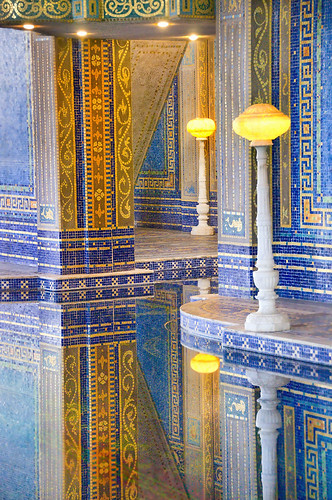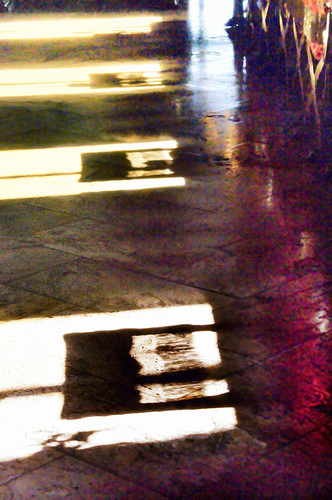This story is going to be one big whine about Hearst Castle as an abomination of an ersatz tourist trap and a monument of hagiography of a capitalistic pig paid for with public money. But before I get to the ranting, let me explain the photographic problem that the two images that go along with this story illustrate. If you are interested only in photography, feel free to skip the whining.
When you get on the tourist bus up to the castle, they make it very clear that you can’t use flash, you can’t use a tripod, and you can’t bring a bag of gear with you. Most of the interior spaces of the castle are pretty dark. So what’s a photographer to do?
I decided to see if I could use high ISO photography for something besides a fish tank. I set my D300 to ISO 6400, and left it there. The photo above shows the inside of one of Heart’s swimming pools at ISO 6400, 1/125 of a second, and f/5.6. Perfectly reasonable for hand holding, and the noise adds a nice Venetian effect to go with the overly decorative swimming pool.
The photo below shows the shadows of the tasseled chairs in the baronial dining room. This was the kind of dining room that served ketchup and condiments out of the jars along with ranch food and baroque table settings. William Randolph Hearst’s rear end probably sat in one of the chairs whose shadows are shown in this photo.
I wanted plenty of depth of field. This is a situation that would have called for a tripod. Instead, at ISO 6400 I handheld for a 1/50 of a second at f/32 exposure.
View this image larger.
Warning: here comes the whining and ranting. I almost don’t know where to start. So let’s start with the place itself. There are some wonderful decorative touches by architect Julia Morgan, who put bread on her table with Hearst Castle for more than twenty years. But despite tour guide and widescreen-big-movie-that-comes-with-the-admission-ticket-and-you-have-to-sit-and-see-even-on-a-beautiful-day-particularly-if-you-are-traveling-with-kids claims that this building somehow exemplifies Spanish and Italian vernacular religious architecture, the only thing Hearst castle exemplifies is gaudy and tasteless California mish-mash. In fact, Hearst Castle may have set the gold standard for ostentatious, tasteless, and awful that all other California buildings only aspire to.
My six-year-old Nicky’s complaint was down somewhat different lines: “If this is a castle, why doesn’t it have battlements?”
The Hearst family seems to have done themselves well out of this setup. They kept 35,000 acres as a private ranch and vacation retreat, and donated to the state the expensive to maintain hundred acres that the castle building sits on. Off-loading the expensive maintainence headache to the taxpayers was very slick, and it seems that as part of the deal they got sentimental tributes to the Hearst family greatness in the required film, with violin music in the background. The material does recount a bit about the great Comstock silver lode, but there is an absence of information about the (apparently hereditary) family fondness for showgirls, and no mention at all of Patty Hearst.
By the way, this isn’t a cheap place to visit. The basic tour for one adult, a six year old, and a ten year old cost $40.00.
On the crammed bus ride up the hill, along with the prohibition on flash, the recording tells one that it is OK to take photos for personal use, but they can’t be published except with written permission. This seems really unreasonable for a facility that is supported with public money, and mostly about keeping a monopoly on tourist tchatkes.
So here and now, Hearst Castle people, I’ve published these photos in my blog. I don’t have permission. Come and get me.


Pingback: Photoblog 2.0: » Photoblog 2.0 Archive: » Making a Digital Collage
Pingback: Photoblog 2.0: » Photoblog 2.0 Archive: » Blossoms and Sensitivity